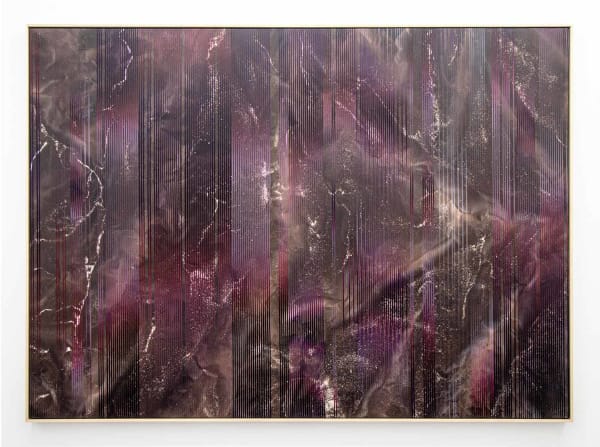Stasis field: Julius Göthlin
In Julius Göthlin’s third solo exhibition at Belenius, there is a conscious nod to the works from the two previous exhibitions, that converts to an expansion where gravity pulls the total towards the middle and makes everything meet, thus becoming one. The repetitive and confined are mixed with an organic, intuitive and material-driven approach. Optical illusions and mobility merge with Göthlin’s critique of the present, a way of dealing with our obsession with social media and its algorithms.
In Julius Göthlin’s third solo exhibition at Belenius, there is a conscious nod to the works from the two previous exhibitions, that converts to an expansion where gravity pulls the total towards the middle and makes everything meet, thus becoming one. The repetitive and confined are mixed with an organic, intuitive and material-driven approach. Optical illusions and mobility merge with Göthlin’s critique of the present, a way of dealing with our obsession with social media and its algorithms.
The title of the exhibition is a concept taken from the science fiction universe, a theoretical force field somewhere in cosmos where time stands still, and everything in its parameters ceases to age. As reality around us has been digitized at a rapid pace and the eternal has become temporal, the artist wants to stop and reflect within this force field. Had it been possible to freeze time, the works had been inside this very Stasis Field. It is a protest against the linear, an imaginary possibility for something that transcends the normalized.
During the creative process, Göthlin emancipates himself from his own involvement with the works utilizing external elements – sand, water and wind, which are free to play over the acrylic on the canvas. In this way, the cosmic expression take shape, as an autonomous event. The paintings are thus at the time of their creation in a Stasis Field. Since childhood, Göthlin has been interested in movement, in the two-dimensional, repetitions that eventually tear themselves free and call for transformation. The paintings were born out of an idea of other dimensions, within the layers upon layers that were painted. The sculptures capture these parallel realities and reflect them, but also the opposite. The stripes are part of the bigger picture. Mathematically and dreamlike, they fight anxious conformism and supple consensus. Göthlin says that the works are an interpretation of each other, without de facto being anything at all.
Violet is one of the seven traditional spectral colors having the shortest wavelength. For us to be able to see color, a mixture of many different wavelengths is required. Ultraviolet with shorter wavelength cannot be perceived by the human eye. Göthlin’s wish is that it should not be possible to decode the works directly. Perhaps a painting or sculpture done in ultraviolet colors would have automatically ended up in a Stasis Field, an abstraction beyond our comprehension, had it been possible. It is the artist that set the parameters concerning the works and their creation process, but it is also Göthlin who determines their algorithm. Within their limits there is freedom, but he is the one who created the conditions. This becomes a metaphor for a larger context – who really determines the human condition, who makes our algorithms within which we all operate? Göthlin wants to take control of the uncontrollable. Painting can be fantastic and beautiful according to the artist, but when you see the brushstrokes, it is difficult to get around the idea that it is a human being who is behind it. It is an image passing via a human being, not material that communicates autonomously. Therefore, the traces of Göthlin as a sender are circumvented by the fact that he never touches the canvas when the paint is applied with an airbrush. In Stasis Field we get to see Julius Göthlin’s personal interpretation of a reality disconnected from algorithms and the infinite loop where the works stand on their own in relation to the digital flow.
/Valter Sydén
Julius Göthlin (b.1984) lives and works in Stockholm, Sweden. In 2012, he earned his MFA in Fine Arts from the Royal Institute of Art in Stockholm.
Julius Göthlin´s work is rendered in softly airbrushed tones reflecting both minimal, as well as abstract approaches. His work delivers both a visual gravity and an equally gradual presentation of forms, which slowly progresses while exploring the artist’s abstract work. The artist underlines the power of “moving” in his compositions questioning notions of time and space while composing work of confident and mesmerizing beauty, while also emphasizing the intellectual and non-material quests that characterize our contemporary age.
His work has been presented nationally in Sweden and internationally in countries such as Italy, India and Denmark.








